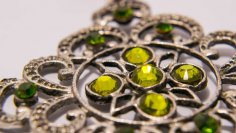
Evaluating and buying emeralds is a tricky business. It is almost impossible for a non-specialist or an ordinary buyer to correctly evaluate this stone. Therefore, the best way to evaluate an emerald is to contact a reliable jeweler or gemstone dealer. But even experts can have different opinions.
You can also ask for a quality certificate before buying an emerald. There are many institutions around the world that certify precious stones. Not all of them are technically reliable, so only a few can be relied on.
The most famous company that certifies the quality of emeralds and other colored stones is Gublin Laboratory (Switzerland). Then comes the Gemological Institute of America (GIA). The Export Promotion Council of India also certifies gemstones.
Major emerald producing countries such as Colombia and Brazil have associations that attest to their reputation as exporters and traders.
Scientific methods for determining the naturalness of emeralds
Any serious emerald buyer should use the services of a gemologist, as they use a variety of laboratory tests to evaluate the true nature of natural and synthetic emeralds.
They first check visual features such as clarity with a magnifying glass and use a binocular microscope to examine more complex features such as color and inclusions. To determine the difference between a natural emerald and a synthetic one, they use a scientific instrument known as a spectroscope. This instrument allows them to determine the exact color characteristic of the stone – its absorption spectrum.
Raman spectroscopy is the advanced method for evaluating inclusions in synthetic emeralds. Gemologists also often use modern testing tools such as energy-depressed X-ray fluorescence (EDXRF). No one can tell a natural emerald from a synthetic without a thorough knowledge of the subject.
The simplest criteria by which one can distinguish an emerald from a fake or imitation are specific gravity and optical density. People buying emerald should know that the specific gravity of a natural emerald is often between 2.70 and 2.78, and the refractive index is always between 1576 and 1582.
There are many ways to confuse an emerald with other similar colored stones. Careful examination under 10x magnification and experience can go a long way in distinguishing between a natural emerald and a synthetic, fake, or imitation. However, to be absolutely sure, it is necessary to consult a gemologist with the right equipment.
How to know if an emerald is natural or synthetic?
Distinguishing natural emerald from synthetic is difficult because the chemical composition, optical and physical properties of synthetic stones are almost identical to those of natural emeralds. Some of the latest synthesis techniques also involve placing natural-looking inclusions characteristic of natural emeralds into the created stones.
If a very intense green emerald, very clear and brilliant, is presented to a potential buyer as a natural emerald, and the price is less than USD 500.00 per carat, the buyer should be aware that this is not a realistic price for a natural emerald of this quality. Natural emeralds are more expensive.
Technically, it is not a crime to represent a created emerald as “real” since it has the same chemical composition and structure as a natural emerald. The important question is: “is it a natural or created emerald?” Most dealers will agree that an emerald is created; it would be unethical to pass off a created emerald as natural. Sellers who do not do so are misleading the public.
If you want to determine whether the emerald you have is synthetic or natural, you should take it to a competent laboratory for analysis. Because of the similarities between the two, for accurate analysis, emerald should be left in the hands of qualified gemologists who have the analytical tools necessary to determine the differences between the two.





